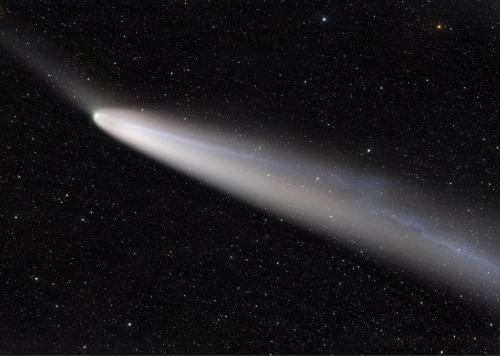Geminid Meteors Over Chile

Geminid Meteors over Chile
Credits: Yuri Beletsky, Carnegie, Las Campanas Observatory, TWAN
More Posts from Astronomyandgalaxies and Others
Like images of broken light, Webb captured these carbon-rich dust shells around a binary star system. Drifting swiftly outwards, they are seeding their surroundings with carbon - one way elements spread across the universe.
go.nasa.gov/4ahBqmX


C/2023 A3 (Tsuchinshan-ATLAS) 2024-10-23, clearest photo ever taken of a comet!

Globular Cluster
NGC 1850 is a fascinating globular cluster located in the Large Magellanic Cloud, a satellite galaxy of the Milky Way.
It is situated approximately 160,000 light-years away from Earth in the constellation Dorado.
NGC 1850 is notable for its rich population of stars and its complex structure, which includes multiple stellar populations.
Credits: NASA, ESA and P. Goudfrooij (Space Telescope Science Institute); Processing: Gladys Kober (NASA/Catholic University of America)

NGC 6543 Widefield (HAO3LRGB) Cats Eye!


Approaching the Agena target vehicle, earth horizon in background, Gemini VIII.
Neptune

Neptune is dark, cold, and very windy. It's the last of the planets in our solar system. It's more than 30 times as far from the sun as Earth is. Neptune is very similar to Uranus. It's made of a thick fog of water, ammonia, and methane over an Earth-sized solid center. Its atmosphere is made of hydrogen, helium, and methane. The methane gives Neptune the same blue color as Uranus. Neptune has six rings, but they're very hard to see



" Nasa's Deep Space Mission " //© Astro Voyagers

Orion Nebula photo 114 Years apart
The 1901 photo was taken by George Ritchey at Yerkes Observatory, using a 24 Inch (609mm) reflecting telescope. Amazing how far Astronomy has come
-
 sergej963 liked this · 3 months ago
sergej963 liked this · 3 months ago -
 uthirstyor reblogged this · 3 months ago
uthirstyor reblogged this · 3 months ago -
 uthirstyor liked this · 3 months ago
uthirstyor liked this · 3 months ago -
 silvereyedowl reblogged this · 3 months ago
silvereyedowl reblogged this · 3 months ago -
 di5app34r liked this · 3 months ago
di5app34r liked this · 3 months ago -
 bellaralutare liked this · 3 months ago
bellaralutare liked this · 3 months ago -
 marisizrael liked this · 3 months ago
marisizrael liked this · 3 months ago -
 royal-specialty liked this · 3 months ago
royal-specialty liked this · 3 months ago -
 dr4gon-four liked this · 3 months ago
dr4gon-four liked this · 3 months ago -
 sir-deltronk reblogged this · 3 months ago
sir-deltronk reblogged this · 3 months ago -
 huele-a-deprimido liked this · 3 months ago
huele-a-deprimido liked this · 3 months ago -
 orionoidfan liked this · 3 months ago
orionoidfan liked this · 3 months ago -
 snoork007 liked this · 3 months ago
snoork007 liked this · 3 months ago -
 d4n1k9s reblogged this · 3 months ago
d4n1k9s reblogged this · 3 months ago -
 d4n1k9s liked this · 3 months ago
d4n1k9s liked this · 3 months ago -
 ursulo4 liked this · 3 months ago
ursulo4 liked this · 3 months ago -
 karlfelersii liked this · 3 months ago
karlfelersii liked this · 3 months ago -
 yanngi liked this · 3 months ago
yanngi liked this · 3 months ago -
 luciyaya reblogged this · 3 months ago
luciyaya reblogged this · 3 months ago -
 divination1330 liked this · 3 months ago
divination1330 liked this · 3 months ago -
 cousinbat reblogged this · 3 months ago
cousinbat reblogged this · 3 months ago -
 pipuisci reblogged this · 3 months ago
pipuisci reblogged this · 3 months ago -
 infinite-vincent liked this · 3 months ago
infinite-vincent liked this · 3 months ago -
 joeldenverxxx69 liked this · 3 months ago
joeldenverxxx69 liked this · 3 months ago -
 curiokhan0113 liked this · 3 months ago
curiokhan0113 liked this · 3 months ago -
 dustydev-rambles-sometimes liked this · 3 months ago
dustydev-rambles-sometimes liked this · 3 months ago -
 shadowmilksblog liked this · 3 months ago
shadowmilksblog liked this · 3 months ago -
 slaphappydonut liked this · 3 months ago
slaphappydonut liked this · 3 months ago -
 cortowskibook liked this · 3 months ago
cortowskibook liked this · 3 months ago -
 sylvanthorn reblogged this · 3 months ago
sylvanthorn reblogged this · 3 months ago -
 sylvanthorn liked this · 3 months ago
sylvanthorn liked this · 3 months ago -
 gzlbfatcat liked this · 3 months ago
gzlbfatcat liked this · 3 months ago -
 astr0-1101 liked this · 3 months ago
astr0-1101 liked this · 3 months ago -
 victor-ribeiro-stuff reblogged this · 3 months ago
victor-ribeiro-stuff reblogged this · 3 months ago -
 qurlymane liked this · 3 months ago
qurlymane liked this · 3 months ago -
 victor-ribeiro-stuff liked this · 3 months ago
victor-ribeiro-stuff liked this · 3 months ago -
 liampaivinen liked this · 3 months ago
liampaivinen liked this · 3 months ago -
 halluzinocat liked this · 3 months ago
halluzinocat liked this · 3 months ago -
 thefoxtrot008 liked this · 3 months ago
thefoxtrot008 liked this · 3 months ago -
 snoooy9060 liked this · 3 months ago
snoooy9060 liked this · 3 months ago -
 davland09 liked this · 4 months ago
davland09 liked this · 4 months ago -
 bandtrash0818 liked this · 4 months ago
bandtrash0818 liked this · 4 months ago


